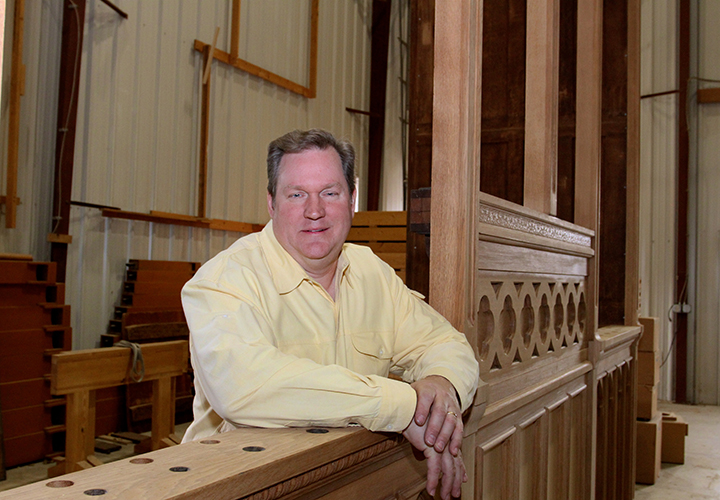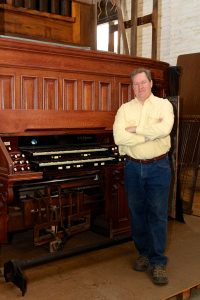
By Sadie Hunter
For 25 years, Geist resident Rob Heighway has been building pipe organs as an employee of Goulding & Wood Pipe Organ Builders at 823 Massachusettes Ave. in Indianapolis, which was founded in 1980.
And although he doesn’t play the pipe organ himself, Heighway does have a musical background in theater and choir.
“I did a lot of work in high school in choirs, singing. I went to college to actually be an actor,” he said. “Growing up, my dad and I, we liked to goof around out in the garage and build things and make things, but never really on a serious level. It wasn’t really until I was in college where I started building theater sets as part of my theater programming. I really enjoyed it, and the woodworking just sort of progressed from there. Pipe organs are woodworking on a heroic scale; some of the casework and the organs themselves can weigh up to 20,000 pounds. Plus, we build organs thinking we’d like for them to last 100 years or longer. There are 400-year-old organs that are still being played.”

Growing up in Zionsville, Heighway has long been close to Indianapolis. When he first began working at Goulding & Wood, he lived right across the street before moving to the Geist area near 82nd Street and Fall Creek Road approximately 10 years ago.
Although Heighway’s primary day-to-day job includes building new organs, he’s currently working on two restorations.
One of the projects is a pipe organ from 1905 from the Bethel A.M.E. Church, which is Indianapolis’ oldest existing African American church. The church, nearly 150 years old, sold its historic building earlier this year to a hotel developer but saved its pipe organ for its new building.
The other restoration is an organ from The Church of the Enunciation in Brazil, Ind., that dates back to 1885. Heighway just completed building the organ’s casework.
“We also built the organ for the concert hall at Ball State University, the organ that’s over at the Indiana Landmark Center,” Heighway said. “Most of the time we build new organs. That’s our main focus, and we build them all over the United States. We have organs in Louisiana, in the Carolinas, all over. We have one in Dallas, Texas, several in Chicago, several in Washington, D.C. We actually have a contract for next summer to do some additions and a new console for Fifth Avenue Presbyterian Church in New York City, which is caddy-corner from Trump Tower, so it’s right there in a very nice section of the city.
“Locally, I would say the organ that people see the most is at St. Luke’s Methodist at 86th and Meridian Streets,” he said. “It’s a nice, big instrument and used for a lot of things. We did one in Pittsburgh at East Liberty Presbyterian Church. It’s probably the largest organ we’ve done. It’s very impressive inside a beautiful cathedral.”
In Hamilton County, the company’s work can be seen at the Palladium in Carmel.
“When you go there, the organ pipes that are up on the wall behind the stage, we put those up there, but there’s actually not a pipe organ,” Heighway said. “They have the space for one, and they were planning on putting in one, but then they decided that they didn’t want to spend the money on the organ during the construction of the building. They have a large space behind those pipes set up and ready for an organ. It would be a large concert instrument, probably one of the largest in the state. It’s a world-class performance hall, so they would need a world-class organ.”
FUN FACT
The expression “pulling out all the stops” originates from playing the pipe organ. Heighway says literally pulling out every stop on an organ creates the fullest, loudest sound from the instrument. “The American Heritage of Dictionary Idioms” cites the expression as dating back to as early as 1860.



